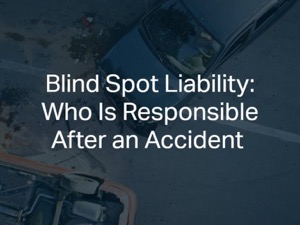
Every vehicle has blind spots. Yes, some vehicles have larger blind spots than others, but every driver needs to be aware that there are areas around their vehicle that they cannot see when they look in their side or rearview mirrors. If a driver fails to check their blind spots before attempting a maneuver with their vehicle, this could result in an accident. Here, our Chicago car accident lawyers want to discuss who can be held liable in the aftermath of a blind spot car accident.
How do Blind Spot Accidents Occur?
We do not know exactly how many accidents occur each year in Illinois that involve blind spots. The reality is that the state Department of Transportation does not keep track of this specific cause of accidents. What is more likely to happen is that a person will face a citation for failing to yield the right of way, failing to signal a turn, or careless operation of a vehicle.
Blind spot accidents occur in a variety of ways, and they can affect drivers and passengers in other vehicles as well as motorcyclists, bicyclists, and pedestrians. All vehicles have blind spots, though larger vehicles such as SUVs and pickup trucks have more prominent blind spot than traditional compact cars. Blind spots can lead to accidents in a variety of ways in Illinois.
- Accidents while reversing. When a person puts their vehicle in reverse, they must check their mirrors to see if there are any obstacles. Additionally, all drivers should physically turn their heads around to look behind the vehicle. Yes, most modern vehicles do now have backup cameras, but these do not cover all of the blind spots.
- Merging accidents. When a person is merging onto a highway or road, they must check to make sure they have a clear path before completing the merger. Although it would be nice if oncoming drivers were courteous and allowed vehicles the space to merge, that is not their responsibility. The merging vehicle has the responsibility for yielding the right of way, and they should only merge when it is safe to do so. Blind spots could lead to a person merging and causing an accident.
- Unsafe lane changes. Lane changes must be done carefully, and these are some of the most common ways that blind spots cause accidents. When a person needs to change lanes, they should check their mirrors and physically turn their heads to see if there are any vehicles in their blind spots in the direction they wish to go.
Who is Responsible for a Blind Spot Accident?
In most cases, a driver who fails to check their blind spots before backing up, merging, or changing lanes will be held liable in the event they run into another vehicle or pedestrian. It is the responsibility of a vehicle driver to be aware of any activity in their own blind spots. There are no laws that state vehicles cannot travel in the blind spots of other vehicles.
Having a blind spot is not a suitable defense against crash liability. Victims in these cases will argue that a reasonable and prudent driver should have been able to process what was going on in their blind spot and should have prevented the accident.
However, these cases can become challenging if two vehicles merge at the same time and collide. In these situations, an investigation will be needed to determine which driver was in the wrong. The at-fault driver will usually be the driver who did not have the right of way, but there are times when more than one party can share liability for an accident. This will inevitably reduce the total amount of compensation a person can receive, or it could eliminate their ability to receive compensation altogether.
 North Chicago & St. Louis Injury Updates
North Chicago & St. Louis Injury Updates

